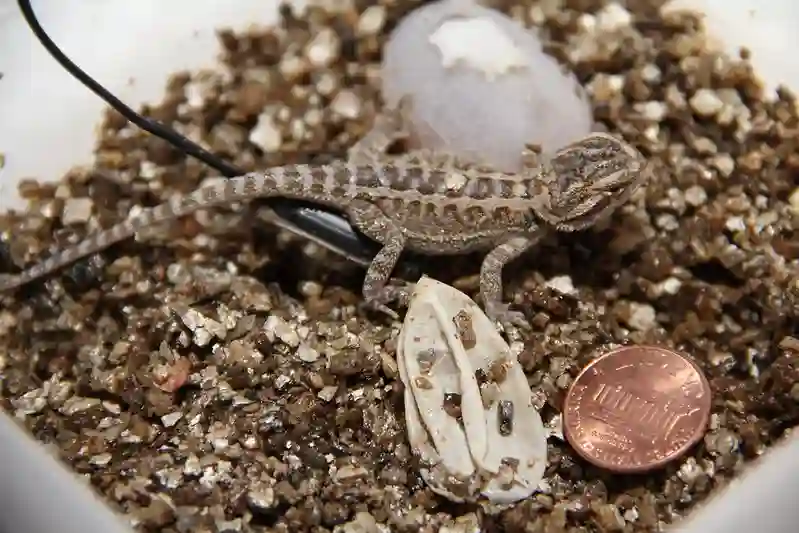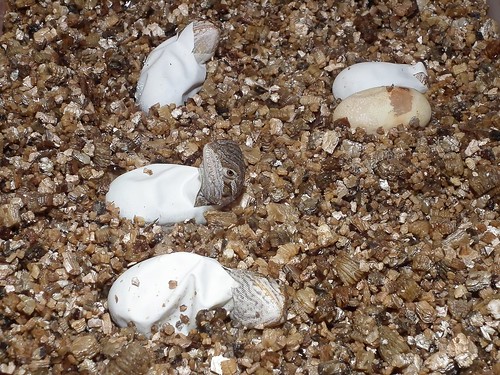Well, folks, the moment has come: your bearded dragon has laid eggs!
But, what’s next?
First, prepare a nesting box with moist sand or soil for the eggs to be laid in. Once the eggs have been laid, you can either move them to an incubator or keep them in the nesting box. In order to ensure proper egg development, the temperature and humidity levels must also be monitored.
The Egg-Laying Process: A Bearded Dragon’s Journey
A mother’s intuition: detecting the gravid state
First things first, it’s important to know when your bearded dragon is gravid, or carrying eggs.
Some tell-tale signs include:
- Swollen belly
- Decreased appetite
- Restlessness
- Frequent digging
Prepping the nursery: setting up the egg-laying site
When you suspect your bearded dragon is gravid, it’s time to set up a proper egg-laying site.
Here’s a quick checklist to get you started:
- A nesting box filled with moist substrate
- Privacy, away from high-traffic areas
- Temperature maintained at 80-85°F (27-29°C)
- A gentle misting to maintain humidity
The big event: egg-laying
Once the stage is set, it’s time to let nature take its course.
Keep a close eye on your bearded dragon, as egg-laying can take anywhere from a few hours to a couple of days.
What to Do if Your Bearded Dragon Lays Eggs? The Essential Steps
Step 1: Carefully collect the eggs
Hold your horses! Before you swoop in to collect the eggs, make sure the mother has finished her job.
When she’s done, carefully scoop out the eggs with a spoon or your fingers, taking care not to jostle or rotate them.
Step 2: Set up the incubator
To ensure the best chance of hatching, set up an incubator with the following features:
- Temperature maintained at 82-85°F (28-29°C)
- Humidity between 70-80%
- A medium like vermiculite or perlite to nestle the eggs
Step 3: Monitor and wait
Patience is a virtue! Keep a watchful eye on the eggs, checking temperature and humidity daily.
The waiting game can take anywhere from 50-80 days, so sit tight.
Problems With Bearded Dragons Laying Eggs
If your bearded dragon lays eggs, it may be a cause for concern. The first thing to understand is that this can happen even if the beardie is not in contact with another.
This phenomenon is known as ‘parthenogenesis’ and occurs when an egg develops without being fertilized by a male. While parthenogenesis does occur naturally in some lizards, including certain types of skinks and geckos, it’s not natural for all species – certainly not for bearded dragons.
When these eggs are laid, they will never hatch because there’s no sperm inside them to help them develop into embryos.
Not only does this mean wasted energy on the part of your pet but also long-term health issues such as calcium deficiency or metabolic bone disease may arise due to the lack of nutrition needed to produce viable eggs.
It’s important to note here too that any female who has produced unfertilized eggs should never be used again for breeding purposes since she cannot pass down healthy genetics from her offspring anymore.
To prevent your bearded dragon from laying these nonviable eggs you’ll want to make sure that their environment is optimized for optimal health: provide plenty of clean water, UVB lighting, dust food items with calcium supplements twice weekly (or more depending on specific needs), and regular checkups at the vet every six months or so.
Finally, ensure that temperatures remain between 85°F and 90°F during daytime hours and 75°F overnight – anything outside of those ranges could increase stress levels which then lead to the overproduction of hormones responsible for stimulating egg production.
Post Egg-Laying Care for Your Bearded Dragon
The importance of recovery
Egg-laying can take a toll on your bearded dragon, so it’s essential to give her time to recuperate. Ensure she has access to plenty of water, food, and basking opportunities.
Check the female
Inspect the female bearded dragon for any retained eggs, which can lead to serious health issues.
If you suspect that she still has eggs inside her, consult a veterinarian immediately.
Calcium supplements: Must
Replenishing calcium levels is crucial for a healthy recovery. Offer calcium-rich foods like leafy greens and insects dusted with calcium powder.
Cleaning the enclosure
Thoroughly clean and disinfect the enclosure to remove any remnants from the egg-laying process. Replace the substrate and ensure that the environment is clean and free from bacteria.
Monitor her behavior
Keep an eye on the female bearded dragon’s behavior and overall health in the days following egg-laying.
Watch for signs of lethargy, loss of appetite, or any other signs of illness. If you notice anything concerning, consult a veterinarian.
Gradually return to normal routine
As the female bearded dragon recovers, gradually return her to her normal routine of basking, feeding, and socializing.
FAQs
Can I handle the eggs immediately after they’re laid?
Yes, but be gentle and avoid rotating the eggs.
How can I tell if the eggs are fertile or not?
Fertile eggs will be plump, white, and have a slightly leathery texture. Infertile eggs will appear yellow, shriveled, or have a chalky appearance.
How long does it take for bearded dragon eggs to hatch?
The incubation period for bearded dragon eggs typically ranges from 50-80 days, depending on temperature and humidity conditions.
Can I incubate the eggs at room temperature?
It is not advisable to incubate bearded dragon eggs at room temperature, as fluctuations can negatively impact the eggs’ development. An incubator specifically designed for reptile eggs is recommended.
How can I tell if the eggs are developing properly?
Regularly inspect the eggs for signs of mold, discoloration, or collapsing. Candling the eggs using a flashlight can also reveal the presence of veins and embryos, indicating healthy development.
What should I do if my bearded dragon lays infertile eggs?
Remove the infertile eggs from the nesting box to prevent mold growth and infection. Monitor your bearded dragon for any signs of illness or distress and consult a veterinarian if necessary.
Conclusion
It’s a common misconception that if your bearded dragon lives alone, it won’t lay eggs. Around 5% of all egg-laying reptiles are known as parthenogenetic species which means they don’t need the help of a mate to produce offspring!
Bearded dragons will usually display nesting behavior when preparing to lay their eggs – so it pays off to be observant and aware of any changes in behavior or activities.
It’s important to recognize these signs early on so you can take the necessary steps for egg incubation and care.


